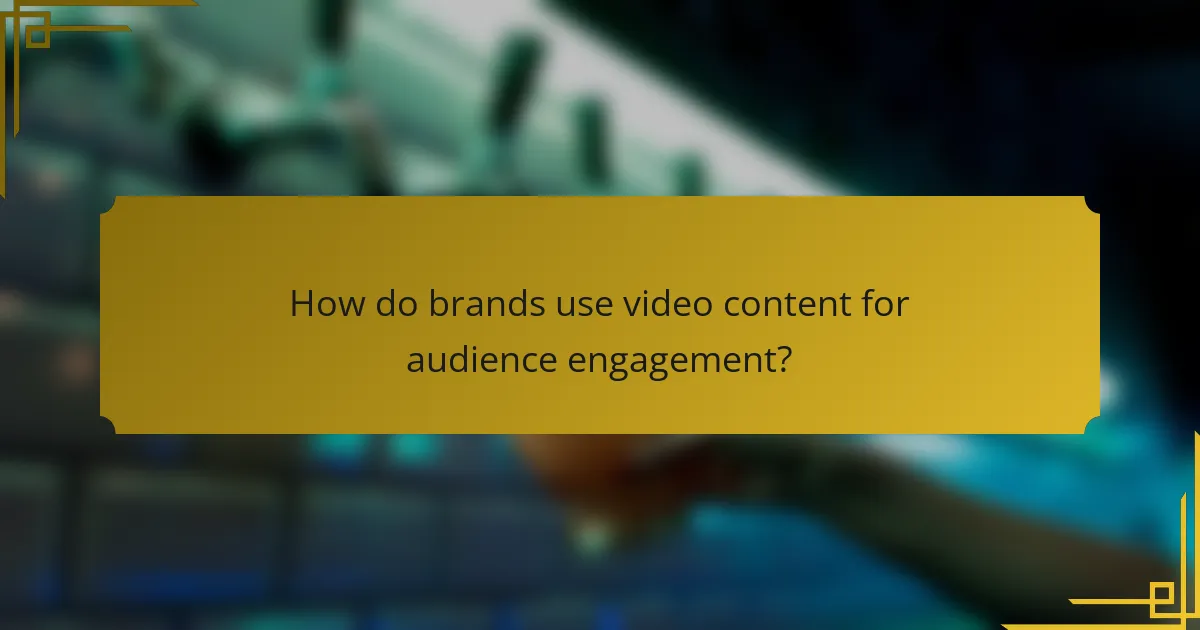Video content serves as a powerful tool for showcasing offerings through engaging visual narratives that highlight key features and real-life applications. By employing storytelling techniques, brands can forge emotional connections with their audience, making products more relatable and memorable. This approach not only enhances brand visibility but also encourages meaningful audience interaction, ultimately leading to stronger customer relationships.

How can video content showcase offerings effectively?
Video content can effectively showcase offerings by providing engaging visual narratives that highlight features, benefits, and real-life applications. This medium allows brands to connect with their audience on an emotional level, making products and services more relatable and memorable.
Product demonstrations
Product demonstrations are a powerful way to showcase offerings by visually illustrating how a product works and its key features. They can range from simple how-to videos to detailed walkthroughs that highlight unique selling points. Consider using clear visuals and concise explanations to keep the audience engaged.
When creating product demos, focus on the most compelling aspects of the product. Aim for a duration of 1-3 minutes to maintain viewer interest, and ensure high-quality visuals to enhance credibility. Including a call-to-action at the end can encourage viewers to learn more or make a purchase.
Customer testimonials
Customer testimonials leverage social proof to showcase offerings by featuring satisfied customers sharing their experiences. These videos can build trust and credibility, as potential buyers often relate more to real users than to marketing messages. Aim for authenticity by showcasing diverse customers and their genuine feedback.
Keep testimonials brief, ideally under 2 minutes, and focus on specific benefits the product has provided. Highlighting relatable challenges and how the offering solved them can resonate well with the target audience. Consider using subtitles for accessibility and to cater to viewers watching without sound.
Behind-the-scenes footage
Behind-the-scenes footage provides insight into the brand’s values, culture, and processes, which can deepen audience connection. This type of content humanizes the brand and can make offerings more relatable by showing the effort and passion that goes into creating products or services.
When producing behind-the-scenes content, aim for a casual and authentic tone. Short clips of team members at work, product development stages, or company events can effectively engage viewers. Keep the content light and entertaining while ensuring it aligns with the brand’s image and message.
Live streaming events
Live streaming events allow brands to interact with their audience in real-time, showcasing offerings while fostering engagement. These events can include product launches, Q&A sessions, or interactive demonstrations, providing an immediate connection with viewers.
To maximize the impact of live streams, promote the event in advance and encourage audience participation through comments and questions. Keep the sessions focused and concise, ideally lasting between 30 minutes to an hour. Post-event, consider sharing highlights or key takeaways to reach those who missed the live broadcast.

What storytelling techniques enhance audience connection?
Storytelling techniques that enhance audience connection include emotional storytelling, character-driven narratives, and visual metaphors. These methods engage viewers on a deeper level, fostering empathy and relatability, which are crucial for effective communication.
Emotional storytelling
Emotional storytelling taps into the audience’s feelings, creating a bond through shared experiences. By using relatable themes such as love, loss, or triumph, content can evoke strong emotional responses that resonate with viewers.
To implement emotional storytelling, consider using personal anecdotes or testimonials that highlight real-life challenges and victories. This approach can increase viewer engagement and encourage them to reflect on their own experiences.
Character-driven narratives
Character-driven narratives focus on well-developed characters that audiences can connect with. These characters often face challenges that mirror the viewer’s struggles, making the story more compelling and relatable.
When crafting character-driven content, ensure your characters are authentic and multidimensional. Viewers are more likely to invest emotionally in stories where they can see parts of themselves reflected in the characters’ journeys.
Visual metaphors
Visual metaphors use imagery to convey complex ideas and emotions succinctly. They can simplify messages and make them more memorable, enhancing the overall storytelling experience.
Incorporate visual metaphors by using symbols or imagery that represent broader concepts. For example, a broken chain can symbolize freedom from constraints. This technique not only engages the audience but also encourages them to think critically about the underlying message.

How do brands use video content for audience engagement?
Brands leverage video content to engage their audiences by creating compelling narratives, showcasing products, and fostering connections. Effective video strategies can enhance brand visibility and encourage audience interaction, leading to stronger customer relationships.
Interactive video features
Interactive video features allow viewers to engage directly with the content, enhancing their overall experience. Elements such as clickable hotspots, quizzes, and polls can transform passive viewing into an active experience, encouraging deeper engagement.
For example, brands can use interactive videos to let users choose their own adventure or explore product features in a gamified format. This not only keeps viewers interested but also provides valuable data on consumer preferences and behaviors.
Social media integration
Integrating video content with social media platforms maximizes reach and engagement. Brands can share videos on platforms like Instagram, Facebook, and TikTok to tap into existing communities and drive traffic back to their websites.
Utilizing features such as stories, reels, or live streams can foster real-time interaction and feedback. Brands should tailor their video content to fit the unique style and audience of each platform for optimal impact.
Community-driven content
Community-driven content involves creating videos that reflect the interests and contributions of the audience. This approach can include user-generated content, testimonials, or collaborative projects that showcase customer stories and experiences.
Encouraging customers to share their own videos related to the brand can create a sense of belonging and loyalty. Brands should consider running contests or campaigns that incentivize audience participation to generate authentic content that resonates with potential customers.

What are the best platforms for video content distribution?
The best platforms for video content distribution include YouTube, Vimeo, Instagram, and TikTok. Each platform has unique features and audience demographics that can enhance your video marketing strategy.
YouTube
YouTube is the largest video-sharing platform, making it ideal for reaching a broad audience. With billions of users, it allows for various content types, from tutorials to vlogs, and supports monetization through ads.
When using YouTube, consider optimizing your video titles, descriptions, and tags for searchability. Engaging thumbnails and consistent posting schedules can significantly increase your visibility and subscriber count.
Vimeo
Vimeo is known for its high-quality video hosting and creative community, making it suitable for filmmakers and artists. It offers customizable video players and advanced privacy settings, which are beneficial for professionals.
Vimeo’s subscription plans provide additional features like analytics and video marketing tools. This platform is ideal for showcasing portfolios or sharing exclusive content with a select audience.
Instagram is a visual-centric platform that supports short video formats, including Stories and Reels. It’s effective for brands looking to engage with younger audiences through eye-catching visuals and quick storytelling.
Utilizing Instagram’s features like hashtags and location tags can enhance discoverability. Regular interaction with followers through comments and direct messages can foster a strong community around your content.
TikTok
TikTok focuses on short, engaging videos, making it perfect for viral content and trends. Its algorithm promotes creativity and authenticity, allowing users to reach a wide audience quickly.
To succeed on TikTok, create content that resonates with current trends and challenges. Consistency and originality are key, as well as engaging with other users through duets and collaborations to expand your reach.

What metrics should be tracked for video content success?
To gauge the success of video content, focus on key metrics such as view count, engagement rate, and conversion rate. These indicators provide insights into audience behavior and the effectiveness of your video in achieving its goals.
View count
View count is the total number of times your video has been watched. This metric serves as a primary indicator of reach and popularity. A higher view count suggests that your content is attracting attention, but it should be analyzed alongside other metrics for a complete picture.
Consider setting benchmarks based on your previous videos or industry standards. For instance, a view count in the low thousands might be expected for niche content, while viral videos can reach millions. Tracking trends over time can help assess the growth of your audience.
Engagement rate
Engagement rate measures how actively viewers interact with your video through likes, shares, comments, and watch time. A higher engagement rate indicates that your content resonates with the audience, prompting them to take action. This metric is crucial for understanding viewer interest and satisfaction.
To calculate engagement rate, divide the total interactions by the total views and multiply by 100. Aim for engagement rates of around 5-10% for effective content. Be cautious of relying solely on view count, as a high number of views with low engagement can indicate superficial interest.
Conversion rate
Conversion rate tracks the percentage of viewers who take a desired action after watching your video, such as signing up for a newsletter or making a purchase. This metric directly reflects the effectiveness of your video in driving business objectives. A higher conversion rate signifies that your content successfully motivates viewers to act.
To improve conversion rates, ensure your video includes clear calls to action and aligns with viewer expectations. Typical conversion rates can vary widely, often ranging from 1-5% for online videos. Regularly test different approaches to find what resonates best with your audience.

How can video content be optimized for search engines?
Video content can be optimized for search engines by focusing on relevant keywords, engaging titles, and proper metadata. These elements help improve visibility in search results and attract a targeted audience.
Keyword-rich titles
Creating keyword-rich titles is essential for optimizing video content for search engines. A title should clearly reflect the video’s content while incorporating relevant keywords that potential viewers are likely to search for.
For example, instead of a vague title like “Cooking Tips,” use “10 Quick Cooking Tips for Busy Professionals.” This not only includes keywords but also specifies the target audience, making it more appealing.
When crafting titles, aim for a length of 50-70 characters to ensure they display fully in search results. Avoid keyword stuffing; instead, focus on clarity and relevance to enhance both searchability and viewer interest.
